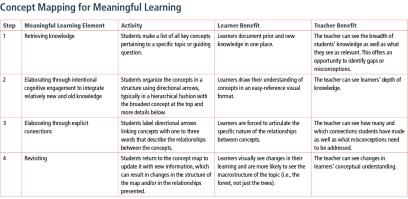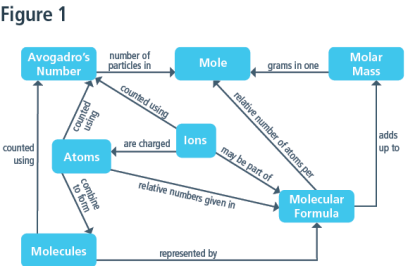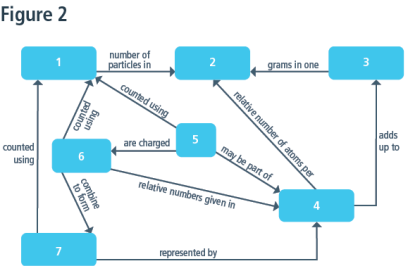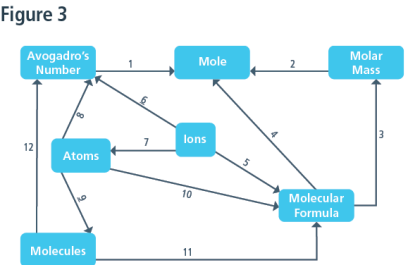I’d like to start this article with a confession: I’m a big fan of concept maps. As a learner, researcher, and educator, I’ve depended on concept maps to become more intentional with my time and to better understand topics. Why? My top two reasons are their efficacy across subjects and age groups and their versatility in application. Here, I delve into what concept maps are, why they are effective, and how we can leverage them in different ways.
What Are Concept Maps?
In their simplest form, concept maps are graphic organizers or visual representations of knowledge, often presented in a node-link-node format. Nodes, which are usually nouns, represent key concepts and are linked by directional arrows labeled with descriptive words that define the relationship between the two nodes. Ideally, the linking words are verbs or contain verbs such that the concepts and linking words read as a sentence (even if the sentence is grammatically incorrect). In the figure below, the map identifies that COVID-19 has highlighted inequities.
Most learners have more than one point of reference for a concept. When each of these conceptual connections are represented in node-link-node format, the resulting diagram is called a “concept map.” Joseph Novak, who has had a long career as a professor of education, research scientist, and business consultant, is often credited with establishing the “modern” body of research on concept mapping. He conducted a landmark 12-year-long study of science concept learning in which students mapped changes in their knowledge structures by constructing concept maps.1 He referred to concept maps as diagrammatic representations of one’s internal knowledge structures.2 This is a powerful description because it acknowledges the fundamental uniqueness of each individual learner’s schema (or mental model) development; this, in turn, suggests no two maps on the same topic need to look the same—there is no “right answer” to a mapping prompt. Concept maps allow learners to showcase what they know and how they organize relevant concepts; they also reveal where there are gaps in their conceptual understanding of a topic.
Are Concept Maps Effective Tools for Learning?
Multiple meta-analyses (which average effects across studies to summarize the available evidence) provide consistent evidence to support the effectiveness of concept maps.3 In fact, they’re more effective—to varying degrees—than learning from lectures, discussions, or text summaries (like outlines or lists). The positive effect on learning has been observed across ages (particularly middle school through higher education), settings (classroom and laboratory), and subject areas (including STEM and non-STEM).4
Many factors impact how effective concept maps are. Looking across studies, effectiveness can depend on context (such as the layout of the map), whether students are studying existing maps or constructing their own, how learning is assessed, how long students focus on the map, and more.
A recent meta-analysis, which is consistent with previous meta-analyses, provided evidence for strong positive effects on learning when a learner constructs a concept map and moderate positive effects when they study a map.5 Constructing concept maps was consistently more effective than studying concept maps. This finding is unsurprising given that constructing concept maps requires deeper and more active cognitive engagement than studying them. After all, learning takes effort. In practice, I’ve observed that students take longer to learn how to make a concept map (which may be less common) than to learn how to read a map (which may be more intuitive).
Why Are Concept Maps Effective?
We’ve seen that constructing concept maps (or concept mapping) and studying concept maps are both effective, but to different degrees. Why? Let’s review theories that ground hypotheses related to the efficacy of concept mapping as well as studying concept maps. However, please keep in mind that these are just hypotheses—the body of research does not yet clearly indicate why concept maps, and especially concept mapping, work.6
Theory Underlying Concept Mapping
At the most basic level, concept mapping is expected to facilitate meaningful learning—learning in which learners purposefully connect new information with their PRIOR knowledge.7 Each emphasized element presents a necessary component for meaningful learning:
- Students must have relevant PRIOR knowledge.
- Students must purposefully link knowledge.
- Students must present key concepts and make explicit, specific connections between these concepts.
These ideas may resonate with most educators as the foundation of their teaching. They also draw parallels to the encoding-storage-retrieval model of learning. By drawing intentional connections between concepts, which may include a mix of new and previously learned concepts, the learner “makes meaning” of the content they are learning.* So, we could say that the practice of concept mapping combines two powerful learning strategies: retrieval practice (as students draw on their prior knowledge) and elaboration (as they add new concepts and make connections) to result in a visual representation of student knowledge.10 The table below explores how the practice of concept mapping expands on these elements of meaningful learning.
(click image to enlarge)
Theory Underlying Studying Concept Maps
Studying concept maps is also expected to support meaningful learning by presenting the macrostructure of a topic, including relationships between concepts.11 This increases the relevance between concepts (i.e., how two concepts are related or inform each other) for learners. Some researchers also advocate for presenting concept maps to provide students with a framework to organize new information.12 Specifically, guiding students’ meaning making by providing maps that use spatial placement (i.e., having closely related concepts close together on the map) and directional arrows with labels may support students who have difficulty reading or limited prior knowledge of the topic in developing their mental schemas on the larger topic.13
Additionally, the graphical representation of key concepts and the relationships between them are hypothesized to present students with less extraneous cognitive load than reading about the topic, which can lead to favorable outcomes in learning.14 For example, in a text, a concept may be repeated multiple times as it is connected to other topics, but in a concept map, each concept is typically only represented by one node irrespective of how many connections it may have to other topics. And, texts usually have complex grammar, but the map is stripped down to the concepts and their linkages. A study tracking students’ eye movements found that students who were provided a concept map in addition to the text spent less time reading the text but still marginally outperformed the group of students who had only the text.15
Another common hypothesis for why studying concept maps is effective is grounded in dual coding theory16 and cognitive theory of multimedia learning.17 Both posit that verbal knowledge (written or spoken text) and mental images reside in separate but interlinked memory channels, and that by leveraging both, we can improve our long-term memory by increasing the number of channels through which the information is later retrieved.
Three Keys to Concept Mapping
There are three key elements to mapping well:18
- Meaning is conveyed by the spacing of concepts; we place two closely connected concepts close together spatially. Think of a family tree as an example.
- The structure of the concepts, such as a hierarchy or cycle, is clear. For example, many concept maps read top to bottom, beginning with the biggest or broadest topic and moving down to the details.
- Connections between concepts are explicit and purposeful. In concept maps, these are represented by directional arrows with linking labels.
In K–12 classrooms, graphic organizers such as story maps, mind maps, knowledge maps, and spider maps are sometimes referred to as concept maps, but they lack one or more of these three critical features. In my experience, the third feature is often missing; students will draw lines or arrows between concepts but will not add labels to describe the connections between the concepts. I find that this omission makes these other graphic organizers far easier to create but also far less useful—not labeling the links can become the root of conceptual misunderstanding. The other forms of graphical organizers can be useful, but it’s helpful to pause and reflect: When would you use a concept map? When would you choose to use other organizers? Why?
Using Concept Maps in Your Classroom
The research on concept mapping is rich and varied in applications, ranging from use as formative assessments19 to supporting critical thinking.20 Let’s look at five ways we can use concept maps in our classrooms, starting with studying a map (the application that requires the least effort by learners) and progressing to independent concept mapping (which requires the greatest effort).21 Student learning is directly proportional to the extent of cognitive effort, so perhaps consider the first two applications for low-stakes learning, as an introduction to concept mapping, or to warm up to applications three through five.
Application 1: Support mastering new information by giving students a concept map that summarizes a topic. Studying expert-created maps (like Figure 1 below) is effective for learning and may be an important first step before students try to construct maps.
(click image to enlarge)
If you are creating the concept map, be cautious of concept map shock, in which a learner is overwhelmed with how much information is in the map. One trick to minimize the likelihood of concept map shock is to use your key learning objectives as the guiding question for constructing your map. In my experience, creating these topic summary concept maps are a challenging and fruitful exercise for us, as subject-matter experts. When creating such maps, I’m forced to acknowledge that I’ve consolidated many small concepts into one big concept—but my students may not have learned about either the bigger concept or its smaller components yet. So, developing the map pushes me to consider the content from my students’ perspective and see the full range of concepts I will need to teach. Other times, creating a map has forced me to reconsider how I am weighting and allocating time to concepts I would like to cover.
Also, keep in mind that giving students the map does not automatically translate to them using the map. They may need training to “read” the map. Research suggests students likely will approach it similar to English text—top to bottom, left to right.22 Near the end of your unit, you may want to ask students to “translate” the map into a few paragraphs (or a short essay, depending on grade level, topic, etc.) and resummarize the information by constructing their own maps. This gives you three hits with one stone—solid instructional planning, your expert concept map to guide your students, and a model for engaging learners in showing their understanding by creating their own maps.
Application 2: Support students to organize their knowledge by completing partially filled concept maps. These map templates can also be used as formative assessments. With a chemistry undergraduate professor, Paul Buckley at Washington State University, my colleagues and I have explored two options for these templates: (1) blanking out key concepts but keeping the relationship labels filled in (see Figure 2 below) or (2) blanking out relationship labels but keeping the concepts filled in (see Figure 3 below).† Completing such concept maps will engage students in retrieving information from their long-term memories (which is an effective strategy for mastering content) and will often highlight for learners (and teachers) what they know and what they need to study further.
(click image to enlarge)
(click image to enlarge)
Due to the templated format, students can receive “answer key” expert maps to self-assess or engage in peer grading and discussions. These templates can also be used as lecture organizers where students fill in the blanks while listening to the lecture.
Application 3: Kickstart the concept map creation process for students by providing a guiding question (framed by your learning target) and a list of concepts. Ask students to draw a concept map in response to the guiding question using the provided concepts. Compared with the two applications above, this approach involves less prep work by teachers while still allowing them to see how well students can demonstrate the relationships between key concepts.
Many students find their first few attempts at concept mapping difficult. Some researchers suggest that practice, feedback, and training on relational framing can help improve the structural quality, elaboration, and relational quality of student mapping.24 It can help such students to write out their responses to the guiding question as a long paragraph and then summarize it as a map. With practice, they may become better at mapping. Of course, providing the text option can bring up questions about the usefulness of creating the map. In such instances, I remind my students that this multimodal format will likely increase their ability to remember the connections. Often, I try to share the science behind constructing concept maps and the idea that there is no right answer for mapping before we begin. Mapping is about documenting our learning process (but is also quick to grade). I also remind learners to use directional arrows and label the arrows with one to three words describing the relationships between concepts.
Application 4: Incorporate concept mapping on a regular basis by having students build a list of concepts in an ongoing manner. This is particularly helpful for learners who are learning brand-new subjects—including all the new terms and their meanings. When the list of concepts is updated regularly (say at the end of every lesson) and a new map is created every week, students have an opportunity to forge relationships between concepts they are learning in an ongoing manner and see changes. The map grows slowly week-on-week; then, at some point, students will realize they need to redraw their maps because they now have a changed understanding of the relationships between concepts or need fewer concepts to showcase the central ideas. This steady approach allows for more practice mapping as well. The revise-and-repeat approach might work better for long units (e.g., ecosystems) or even yearlong courses (e.g., US history). Regular mapping allows teachers to see and address potential misconceptions and/or cognitive dissonance as they emerge.
Revisiting previous concept maps can serve as a great review and allow learners to see how their knowledge structures have changed over time. This mapping can happen at an individual level or even as a collaborative class activity (active concept map wall, anyone?). Whole-class and/or small-group mapping can also serve as a modeling activity for learners to progress toward constructing their own maps independently.
Interestingly, consistently engaging students in concept mapping is effective even with very young children—with the right supports. In one experiment, my colleagues and I worked with kindergartners to help them create concept maps about the weather (see Figure 4 below) using preprinted images, arrows, and labeling words (so they could assemble maps without having to write).25 We also encouraged the children who were just beginning to learn to read to say their linking words aloud. We started with the teacher modeling for the class. Then, students broke into pairs for collaborative concept mapping for three consecutive weeks in which we saw children adding concepts and offering unique interpretations of their maps.
(click image to enlarge)
Application 5: Ask learners to create maps from scratch. Provide learners with a guiding question and scaffold their mapping process by laying out steps:
- Build a parking lot of concepts.
- Prioritize which concepts and relationships to include in response to the guiding question.
- Lay out the concepts keeping in mind the meaning conveyed by how concepts are spaced.
- Connect and label relationships.
- Adjust as necessary.
This construction of concept maps demands intensive cognitive resources and a great deal of time—but also offers rewards in deep learning. Concept mapping may also be good for reviews and/or summative assessments. This application takes the least prep time from an educator, but is only possible when learners have been trained in the practice of concept mapping and feel confident. See Figure 5 below for a concept map I created on concept maps.
(click image to enlarge)
What’s the Catch?
As with all learning strategies, there are tradeoffs involved. With concept mapping, here are several considerations:
- Time: Concept mapping by the educator (e.g., application 1) or by the learner (e.g., application 5) will take a significant chunk of time, depending on how well known the topic is and the scope of the guiding question. In class, I’d budget for at least 15 minutes if we already have a list of concepts ready to map.
- Content: The content usually dictates the format. Some content might naturally lend itself to a cyclical map (e.g., the life cycle of a butterfly) while other topics may be better suited for a diagram rather than a concept map. Choose the format or strategy based on what makes the content explicit.
- Ease of adoption: All forms of meaningful learning take cognitive effort. Some strategies, like quizzing (a form of retrieval practice), are relatively easy to adopt and apply. Concept mapping is different from how most learners document their knowledge; it requires training and practice before showing benefits for learners.
- Cognitive effort: Concept mapping requires extensive processing of concepts (e.g., prioritization of relevance, organization, layout), which can be taxing for some students. Cognitive mapping may be most beneficial when there are complex interactions or relationships that are central to learner understanding.
- Concept map shock: Occasionally, concept maps created by experts may have too many concepts and/or arrows, overloading the learners’ capacity to process and study the map. Having a focused guiding question helps mitigate this risk.
As most educators would agree, these areas of consideration are common when we evaluate any pedagogical strategy, and there is often an element of trial and error as to what works best for which topic—and even which students we have in class. For me, concept mapping will always be among my top strategies to experiment with in my research and practice because of its versatility across the different functions of learning and instruction as well as its ability to capture conceptual understanding in the most remarkable way. After all, there is no pedagogical unicorn, but concept mapping comes close.
Kripa Sundar (NarayanKripa Sundararajan), who earned a doctorate at Washington State University, is an independent consultant, researcher, and parent working to spread the love of learning grounded in the science of learning. She recently created an online module planning kit and published a book for young children, How Do I Learn? Visit her website, kripasundar.com, to learn more.
*In addition to concept mapping, two other strategies that facilitate meaningful learning are self-explanation8 and elaborative interrogation.9 (return to article)
†Our preliminary investigations into the effectiveness of different uses of concept maps had mixed results.23 Students who either translated the expert map into a paragraph or merely studied it outperformed students who filled in partially blank maps. This was surprising given the evidence supporting the construction of maps. Further analysis indicated that when students had sufficient prior knowledge to be able to accurately fill in the blanks, they were more likely able to apply that knowledge to respond to additional questions and to perform better. (return to article)
Endnotes
1. J. Novak and D. Gowin, Learning How to Learn (Cambridge, UK: Cambridge University Press, 1984); and J. Novak and D. Musonda, “A Twelve-Year Longitudinal Study of Science Concept Learning,” American Educational Research Journal 28 (1991): 117–53.
2. J. Novak, “Concept Mapping: A Useful Tool for Science Education,” Journal of Research in Science Teaching 27 (1990): 937–49.
3. P. Horton et al., “An Investigation of the Effectiveness of Concept Mapping as an Instructional Tool,” Science Education 77 (1993): 95–111; J. Nesbit and O. Adesope, “Learning with Concept and Knowledge Maps: A Meta-Analysis,” Review of Educational Research 76 (2006): 413–48; and N. Schroeder et al., “Studying and Constructing Concept Maps: A Meta-Analysis,” Educational Psychology Review 30 (2018): 431–55.
4. Schroeder et al., “Studying and Constructing.”
5. Schroeder et al., “Studying and Constructing.”
6. J. Nesbit and O. Adesope, “Concept Maps for Learning,” in Learning Through Visual Displays, ed. G. Schraw, M. McCrudden, and D. Robinson (Charlotte: Information Age Publishing, 2013), 303–28; and O. Adesope, J. Nesbit, and N. Sundararajan, “The Mapping Principle in Multimedia Learning,” in The Cambridge Handbook of Multimedia Learning, ed. R. Mayer and L. Fiorella (Cambridge, UK: Cambridge University Press, 2021), 351–59.
7. D. Ausubel, “The Use of Advance Organizers in the Learning and Retention of Meaningful Verbal Material,” Journal of Educational Psychology 51, no. 5 (1960): 267–72.
8. M. Chi et al., “Self-Explanations: How Students Study and Use Examples in Learning to Solve Problems,” Cognitive Science 18 (1989): 145–82.
9. J. Dunlosky et al., “Improving Students’ Learning with Effective Learning Techniques: Promising Directions from Cognitive and Educational Psychology,” Psychological Science in the Public Interest 14, no. 1 (2013): 4–58.
10. Adesope, Nesbit, and Sundararajan, “The Mapping Principle.”
11. A. O’Donnell, D. Dansereau, and R. Hall, “Knowledge Maps as Scaffolds for Cognitive Processing,” Educational Psychology Review 14, no. 1 (2002): 71–86.
12. M. Hardiman, R. JohnBull, and D. Carran, “The Effect of Arts-Integrated Instruction on Students’ Memory for Science Content: Results from a Randomized Control Trial Study” (paper presented to American Educational Research Association, San Antonio, TX, April 2017), https://files.eric.ed.gov/fulltext/ED576190.pdf; and M. Hardiman, The Brain-Targeted Teaching Model for 21st-Century Schools (Thousand Oaks, CA: Corwin, 2012).
13. Nesbit and Adesope, “Learning with Concept”; and M. Haugwitz, J. Nesbit, and A. Sandmann, “Cognitive Ability and the Instructional Efficacy of Collaborative Concept Mapping,” Learning and Individual Difference 20 (2010): 536–43.
14. F. Amadieu et al., “Effects of Prior Knowledge and Concept-Map Structure on Disorientation, Cognitive Load, and Learning,” Learning and Instruction 19, no. 5 (2009): 376–86; Nesbit and Adesope, “Concept Maps for Learning”; and Schroeder et al., “Studying and Constructing.”
15. P. Liu, “Using Eye Tracking to Understand Learners’ Reading Process Through the Concept-Mapping Learning Strategy,” Computers & Education 78 (2014): 237–49.
16. A. Paivio, Mental Representations: A Dual Coding Approach (Oxford, UK: Oxford University Press, 1986).
17. R. Mayer, “Cognitive Theory of Multimedia Learning,” in The Cambridge Handbook of Multimedia Learning, ed. R. Mayer, 2nd ed. (Cambridge, UK: Cambridge University Press, 2014), 43–71.
18. Adesope, Nesbit, and Sundararajan, “The Mapping Principle”; and A. Cañas, J. Novak, and P. Reiska, “How Good Is My Concept Map? Am I a Good Cmapper?,” Knowledge Management & E-Learning: An International Journal 7, no. 1 (2015): 6–19.
19. R. Hartmeyer, M. Stevenson, and P. Bentsen, “A Systematic Review of Concept Mapping-Based Formative Assessment Processes in Primary and Secondary Science Education,” Assessment in Education, Principles, Policy & Practice 25, no. 6 (2018): 598–619.
20. M. Yue et al., “The Effectiveness of Concept Mapping on Development of Critical Thinking in Nursing Education: A Systematic Review and Meta-Analysis,” Nurse Education Today 52 (2017): 87–94.
21. These classroom applications were inspired by A. Cañas, J. Novak, and P. Reiska, “Freedom vs. Restriction of Content and Structure During Concept Mapping—Possibilities and Limitations for Construction and Assessment,” in Concept Maps: Theory, Methodology, Technology; Proceedings of the Fifth International Conference on Concept Mapping, vol. 2, ed. A. Cañas, J. Novak, and J. Vanhear (Valletta: University of Malta, 2012).
22. J. Nesbit, H. Larios, and O. Adesope, “How Students Read Concept Maps: A Study of Eye Movements,” in Proceedings of ED-MEDIA 2007 World Conference on Educational Multimedia, Hypermedia & Telecommunications, ed. C. Montgomerie and J. Searle (Vancouver, BC: Association for Advancement of Computing Education, 2007), 3961–70.
23. Z. Wang et al., “Effects of Different Concept Map Activities on Chemistry Learning,” Educational Psychology 41, no. 2 (2021): 245–60; and R. Wong et al., “Static and Interactive Concept Maps for Chemistry Learning,” Educational Psychology 41, no. 2 (2021): 206–23.
24. K. Roessger, B. Daley, and D. Hafez, “Effects of Teaching Concept Mapping Using Practice, Feedback, and Relational Framing,” Learning and Instruction 54 (April 2018): 11–21.
25. N. Sundararajan, O. Adesope, and A. Cavagnetto, “The Process of Collaborative Concept Mapping in Kindergarten and the Effect on Critical Thinking Skills,” Journal of STEM Education 19, no. 1 (2018): 5–19.
[Illustrations by Shaw Nielsen]









